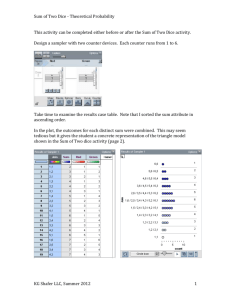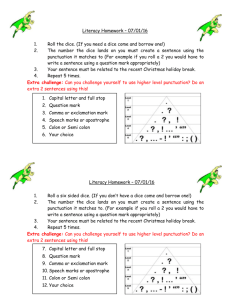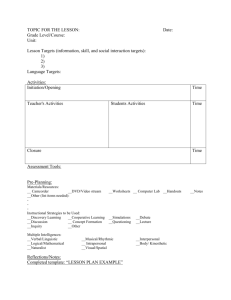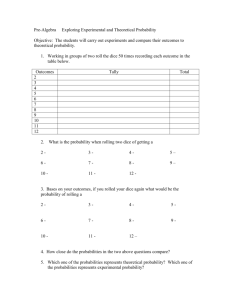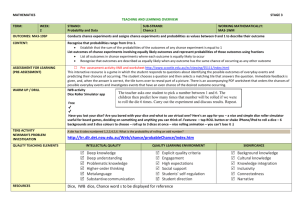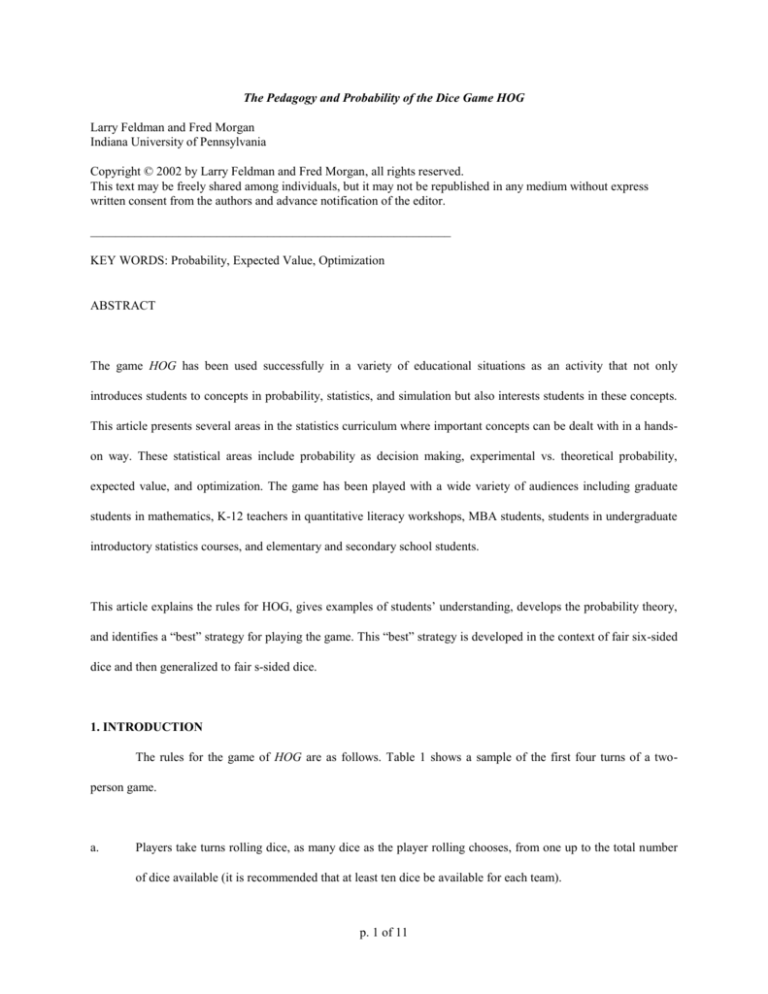
The Pedagogy and Probability of the Dice Game HOG
Larry Feldman and Fred Morgan
Indiana University of Pennsylvania
Copyright © 2002 by Larry Feldman and Fred Morgan, all rights reserved.
This text may be freely shared among individuals, but it may not be republished in any medium without express
written consent from the authors and advance notification of the editor.
_________________________________________________________
KEY WORDS: Probability, Expected Value, Optimization
ABSTRACT
The game HOG has been used successfully in a variety of educational situations as an activity that not only
introduces students to concepts in probability, statistics, and simulation but also interests students in these concepts.
This article presents several areas in the statistics curriculum where important concepts can be dealt with in a handson way. These statistical areas include probability as decision making, experimental vs. theoretical probability,
expected value, and optimization. The game has been played with a wide variety of audiences including graduate
students in mathematics, K-12 teachers in quantitative literacy workshops, MBA students, students in undergraduate
introductory statistics courses, and elementary and secondary school students.
This article explains the rules for HOG, gives examples of students’ understanding, develops the probability theory,
and identifies a “best” strategy for playing the game. This “best” strategy is developed in the context of fair six-sided
dice and then generalized to fair s-sided dice.
1. INTRODUCTION
The rules for the game of HOG are as follows. Table 1 shows a sample of the first four turns of a twoperson game.
a.
Players take turns rolling dice, as many dice as the player rolling chooses, from one up to the total number
of dice available (it is recommended that at least ten dice be available for each team).
p. 1 of 11
b.
The number of dice a player chooses to roll can vary from turn to turn.
c.
The player's score for the turn is 0 if at least one of the dice lands on one; otherwise, the player's score for
the turn is the sum of the dice. Rolling a one does not set the cumulative score to zero, just the score for that
turn.
d.
A running total of the scores per turn are kept for each player.
e.
The first player to reach or exceed a predetermined score (100 works well) wins the game unless more than
one player reaches that score on the same turn; then the player with the highest point total wins the game.
Table 1. Sample of the first 4 turns for a two-person game
Person A’s score
Person
for that roll
cumulative score
2,4,5
11
11
1,4,5,5,6
0
3,4
2,4,4,5,6
Person A rolls
A’s
Person B’s score
Person
for that roll
cumulative score
3,6
9
9
11
2,3,5
10
19
7
18
1,2,2,2,4,6,6
0
19
21
39
3,4
7
26
Person B rolls
B’s
1.1 PROBABILITY AS DECISION MAKING
There exists an obvious trade-off in deciding how many dice to roll. The more dice the player rolls, the less the
likelihood of a non-zero score. Yet if a one does not appear on any of the dice rolled, more dice will lead to a greater
expected score. The number of dice a player chooses to roll may also depend on how far the player is behind or
ahead, or how close the player and the opponents are to winning. These and other factors provide an interesting
activity for students with respect to decision-making in the face of uncertainty.
p. 2 of 11
1.2 EXPERIMENTAL VS. THEORETICAL PROBABILITY
Too often in statistics classes, students are provided with finished results with little motivation. With this game,
students are excited to try out different strategies. After allowing the students time to play against one another using
fair six-sided dice, many students are curious to see if a best strategy exists. To this end, an activity done by the
authors is to assign to a person or small group a fixed number of dice to be rolled. For example, one group must
always roll exactly one die while the next group must always roll exactly two dice and so on. A fixed number of turns
is assigned to the groups (around ten if using actual dice and around thirty if using a simulation).
In playing the game where groups must stick to a fixed number of dice, students get the feeling that perhaps
somewhere around 6 dice is the optimum. However, they see that sometimes 6 is the best, but sometimes other
numbers are best. This helps students to see that the results of experiments may vary and has motivated our students
to find out the “real” (theoretical) answer, which, as will be shown, is to roll either five or six dice.
For example, one of the authors had his “Probability and Statistics for Elementary and Middle School Teachers”
students play the game. After they played the game to 100 in groups of 3-4, each group was asked to list their top 3
guesses for the best number of dice to use. The results are given in Table 2.
Table 2. Students’ guesses for the best number of dice after playing once
Group
Guess of
Guess of
Guess of
Best Number
Second best number
Third best number
A
3
4
2
B
3
2
4
C
4
3
2
D
5
4
3
E
3
2
4
F
4
3
2
p. 3 of 11
For the most part, the students did not believe numbers above 4 would be the best, probably since they overemphasized the effect of getting a zero for a roll.
The groups were then assigned a fixed number of dice to roll ten times with the goal of finding a mean score per roll.
Their findings are in Table 3.
Table 3. Mean values for ten rolls using the same number of dice each time
Number of dice
Mean score per roll
1
3.6
2
5.8
3
5.8
4
8.3
5
8.7
6
8.9
After these results they were asked once again to list their top 3 guesses for the best number of dice to use. The
results are in Table 4. Note that these guesses are closer to the theoretical best number of dice, which is either five or
six dice.
Table 4. Students’ guesses for the best number of dice after finding mean scores
Group
Guess of
Guess of
Guess of
Best Number
Second best number
Third best number
A
4
5
3
B
3
5
4
C
5
6
4
p. 4 of 11
D
6
5
4
E
5
4
3
F
5
4
6
Within each group, each person then chose a number to stick with for each roll. The winner for two of the tables was
the person who chose 5. For another two tables the winner was the person who chose 6 and for another table it was
10.
1.3 EXPECTED VALUE
Often expected value is presented as a formula that students do not understand intuitively. For many students a visual
approach to expected value can be very meaningful such as Table 5 for the expected score for rolling just one die.
Table 5. Equally likely scores, rolling 1 die.
0
2
3
4
5
6
Mean of all scores = 3 1/3, Mean of non-zero scores = 4
The expected value for 1 die can be computed by taking (1/6 x 0) + (1/6 x 2) + (1/6 x 3) + (1/6 x 4) + (1/6 x 5) +
(1/6 x 6) = 20/6 = 3 1/3. If you roll 1 die ten times, your expected score will be approximately 33. Since the mean of
the non-zero values (2, 3, 4, 5, and 6) is 4, the concept of conditional expectations can be introduced by calculating
the expected value for 1 die as (1/6 x 0) + (5/6 x 4) = 20/6 = 3 1/3.
Table 6 shows that with 2 dice the expected value is 200/36 or approximately 5.56, since the sum of all the numbers
in the 36 boxes is 200 and each outcome is equally likely.
p. 5 of 11
Table 6. Equally likely scores, rolling 2 dice
Die #1
1
2
3
4
5
6
Die #2
1
0
0
0
0
0
0
2
0
4
5
6
7
8
3
0
5
6
7
8
9
4
0
6
7
8
9
10
5
0
7
8
9
10
11
6
0
8
9
10
11
12
Mean of all scores = 5 5/9. Mean of non-zero scores = 8
The non-zero area in this table can be represented by 5/6 of the possible outcomes for Die #1 times 5/6 of the
possible outcomes for Die #2 or 25/36. The mean of the non-zero values will be 4 times the number of dice (4x2 = 8
for two dice). Using conditional expectations, the expected value is determined by (5/6 x 5/6 x 8) = 200/36. For the
general case, there will be 5 non-zero values out of 6 for each die used, so the probability of scoring positive points
with a roll is (5/6)^n, where n denotes the number of dice rolled. Given that no 1 is rolled, the expected score is 4n,
since 4 is the mean of 2, 3, 4, 5, and 6. The expected score is then the product of the probability of a positive score
with the conditional expectation given a positive score, namely (4n)*(5/6)^n. These values are shown in Table 7..
Table 7. Expected scores for rolling 1-12 fair six-sided dice
No. of
Probability
Score
Probability
Dice
of a 1
for a 1
of no 1's
1
0.167
0
0.833
2
0.306
0
0.694
3
0.421
0
0.579
4
0.518
0
0.482
5
0.598
0
0.402
6
0.665
0
0.335
7
0.721
0
0.279
8
0.767
0
0.233
9
0.806
0
0.194
10
0.838
0
0.162
11
0.865
0
0.135
12
0.888
0
0.112
Expected score
given no 1’s
4
8
12
16
20
24
28
32
36
40
44
48
The graph of the expected score function for up to 40 fair six-sided dice is shown in Figure 1.
p. 6 of 11
Expected
score
3.333
5.556
6.944
7.716
8.038
8.038
7.814
7.442
6.977
6.460
5.922
5.384
Figure 1. Expected scores for 1 to 40 fair six-sided dice
Hog Expected Value
9
8
Expected Value
7
6
5
4
3
2
1
0
1
3
5
7
9
11
13
15
17
19
21
23
25
27
29
31
33
35
37
No. Of Dice
Thus, an optimal strategy would be to use either 5 or 6 dice for each roll. Of course, you still might want to change
the number of dice you roll if you are far behind or far ahead.
2. Extension to fair s-sided dice
One of the authors was using this activity with an MBA class when a student asked what an optimal strategy would
be for ten-sided dice. This led to the author’s search for the optimal strategy for a fair s-sided dice. The results below
show that the optimal strategy is to use s-1 or s dice for a fair s-sided die.
Let
s = the number of sides for the dice being used
p. 7 of 11
39
k = the number of dice rolled
and
p = the probability of no 1 occurring =
(s 1)
.
s
For
X
= the sum of the dice
k
=
Y
=
X (where X = the number of dots on the top face of the i
i
{
i
th
die)
0, at least one of the dice is a 1
1, none of the dice are 1’s
then
U = score per turn = XY.
The expected score per turn is given by
E(U) = E(XY) = EY[E[(XY)|Y]
(if Y=0)
(if Y=1)
k
- pk ] +
E(X )
i
pk
2 3 ... s k
]p
(s 1)
s(s 1) /2 1 k
p ,
(s 1)
s(s 1) 2 k
=k
p
2(s 1)
(s 2)(s 1)
pk
=k
2(s 1)
s 2 k
=k(
) p
2
(since 1+2+3+…+n = n(n+1)/2)
= k
(formula 1)
The value of k that maximizes the expected score is also the value that maximizes the natural logarithm of the
expected score. Thus,
p. 8 of 11
d
d
s 2
1
[lnE(U)] =
[ln k + ln
+ k ln p] =
+ ln p = 0
dk
dk
2
k
implies
k =
1
1
=
ln( p) ln( s )
s 1
(formula 2)
Since k must be an integer, more analysis is required to determine which integer on either side of formula 2 achieves
the maximum.
Since
ln(
s
) = ln(s) ln(s1)
s 1
s 1
= s1 dx
x
1
s
(see Figure 2),
then
s
1
.
s
ln(
)
s 1
Figure 2. Graph of Y = 1 / X
Similarly,
p. 9 of 11
Therefore,
s-1
1
s
ln(
)
s 1
s-1
1
< s
s
ln(
)
s 1
Using the first derivative test for test values s-1 and s, it is easy to show that the value for k in formula 2 above
maximizes the expected score. This
number k is between s-1 and s, which are consecutive integers. Therefore,
substituting k=s and k=s-1 into formula 1, we find:
E(U ) |k s1 E(U ) |k s
(s 1) s s 2
(
).
ss1
2
The number of dice to be rolled, k, that will maximize the expected score per turn is s-1 or s. For the standard die
this means the number of dice to roll to maximize the expected score is 5 or 6. An interesting variation would be to
flip coins, using heads as 1 and tails as 2. The maximum expected value then would be to flip 1 or 2 coins.
As an extension, it can be shown that the variance of a player's score per turn is:
Var(U) = Var(XY) = EY[Var(XY|Y)] + VarY[E(XY|Y)]
= k[
(s 1) 2 1
s 2 2
k
k
k(
) (1 p )] p
12
2
3. SUMMARY
The HOG game can be played and analyzed by elementary school children up through graduate statistics students.
The authors have been involved with SEQuaL (Statistics Education through Quantitative Literacy), which provides
QL workshops for K-12 teachers at sites throughout Pennsylvania. This activity is typical of the kinds of activities
that teachers and their students enjoy the most. It is a fun activity that has “hidden” deep probabilistic, statistical and
mathematical concepts. These embedded concepts can be adapted for students at a wide variety of levels.
p. 10 of 11
Bibliography
Bohan, James F. and John L. Schultz, “Revisiting and Extending the Hog Game” in The Mathematics Teacher, Vol.
89 No. 9, December 1996, pp. 728-733,
Mathematical Sciences Education Board. Measuring Up: Prototypes for Mathematics Assessment. Washington,
D.C.: National Academy Press, 1993.
p. 11 of 11



